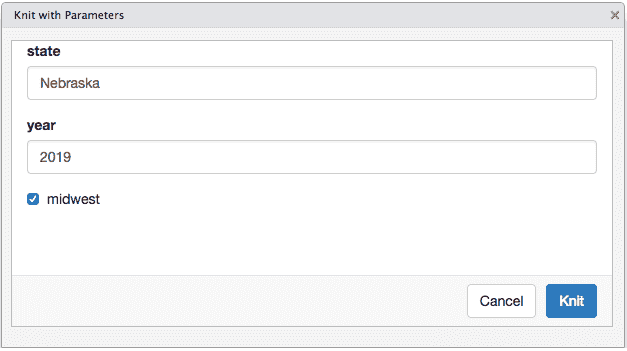17.4 Parameterized reports
In Section 17.3, we mentioned one way to render a series of reports in a for-loop. In fact, rmarkdown::render() has an argument named params specifically designed for this task. You can parameterize your report through this argument. When you specify parameters for a report, you can use the variable params in your report. For example, if you call:
for (state in state.name) {
rmarkdown::render('input.Rmd', params = list(state = state))
}then in input.Rmd, the object params will be a list that contains the state variable:
---
title: "A report for `r params$state`"
output: html_document
---
The area of `r params$state` is
`r state.area[state.name == params$state]`
square miles.Another way to specify parameters for a report is to use the YAML field params, e.g.,
---
title: Parameterized reports
output: html_document
params:
state: Nebraska
year: 2019
midwest: true
---Note that you can include as many parameters in the params YAML field or the params argument of rmarkdown::render(). If both the YAML field and the argument are present, the parameter values in the argument will override the corresponding parameters in YAML. For example, when we call rmarkdown::render(..., params = list(state = 'Iowa', year = 2018) on the previous example that has the params field, params$state will become Iowa (instead of Nebraska) and params$year will become 2018 (instead of 2019) in the R Markdown document.
When rendering the same R Markdown document to a series of reports, you need to adjust the output_file argument of rmarkdown::render(), to make sure each report has its unique filename. Otherwise, you will accidentally override certain report files. For example, you can write a function to generate a report for each state and each year:
render_one <- function(state, year) {
# assuming the output format of input.Rmd is PDF
rmarkdown::render(
'input.Rmd',
output_file = paste0(state, '-', year, '.pdf'),
params = list(state = state, year = year),
envir = parent.frame()
)
}Then you can use nested for-loops to generate all reports:
for (state in state.name) {
for (year in 2000:2020) {
render_one(state, year)
}
}At the end, you will get a series of report files like Alabama-2000.pdf, Alabama-2001.pdf, …, Wyoming-2019.pdf, and Wyoming-2020.pdf.
For parameterized reports, you can also input parameters interactively through a graphical user interface (GUI) created from Shiny. This requires you to provide a params field in YAML, and rmarkdown will automatically create the GUI using the appropriate input widgets for each parameter (e.g., a checkbox will be provided for a Boolean parameter).
To start the GUI, you can call rmarkdown::render() with params = 'ask' if you do not use RStudio:
rmarkdown::render("input.Rmd", params = "ask")If you use RStudio, you can click the menu Knit with Parameters behind the Knit button. Figure 17.1 shows an example GUI for parameters.

FIGURE 17.1: Knit an R Markdown document with parameters that you can input from a GUI.
For more information on parameterized reports, you may read Chapter 15 of the R Markdown Definitive Guide (Xie, Allaire, and Grolemund 2018).